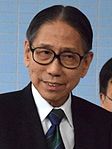Hong Kong legislative election, 1991
|
|
|||||||||||||||||||||||||||||||||||||||||||||||||||||||||||||||||||||||||||||||||||||||||||||||||||||||||||
|
|||||||||||||||||||||||||||||||||||||||||||||||||||||||||||||||||||||||||||||||||||||||||||||||||||||||||||
|
|||||||||||||||||||||||||||||||||||||||||||||||||||||||||||||||||||||||||||||||||||||||||||||||||||||||||||
|
|
|||||||||||||||||||||||||||||||||||||||||||||||||||||||||||||||||||||||||||||||||||||||||||||||||||||||||||
| Elected candidates by each geographical constituency ■ – United Democrats ■ – Meeting Point ■ – ADPL ■ – Independent |
|||||||||||||||||||||||||||||||||||||||||||||||||||||||||||||||||||||||||||||||||||||||||||||||||||||||||||
■ – United Democrats ■ – Meeting Point ■ – ADPL ■ – Independent
The 1991 Hong Kong Legislative Council election for members of the Legislative Council of Hong Kong (LegCo). The election of the members of functional constituencies was held on 12 September 1991 and the election of geographical constituency seats was held on 15 September. It was the first ever direct election of the Legislative Council in Hong Kong history. There were 18 members from directly elected Geographical Constituencies, 21 members from Functional Constituencies, 17 members appointed by the Governor, and 3 official members.
A coalition of the United Democrats and the Meeting Point, together with other smaller parties, groups and independents in the pro-democracy camp had a landslide victory, getting 16 of the 18 geographical constituency seats.
Two-seat constituency two vote system was used with two seats to be filled in each constituency. The voting system helped the pro-democracy coalition win with landslide success and faced criticisms. In the end, the government prescribed simple plurality in the next election.
After the Sino-British Joint Declaration signed in December 1984 stated the sovereignty of Hong Kong would be transferred from the United Kingdom to the People's Republic of China, the pace of the democratisation towards a government of high autonomy towards 1997 became a major political debate. The Hong Kong government denied to the demand of the pro-democracy group of introducing direct elections in the 1988 Legislative Council elections, due to the main opposition from Beijing and the conservative business and professional elites. The Functional Constituencies elected by different business and professional sectors and also Electoral Colleges elected by the District Boards and the two municipal councils (Urban Council and Regional Council) remained in the 1988 elections but it was promised that direct elections would be introduced in the 1991 elections.
...
Wikipedia





